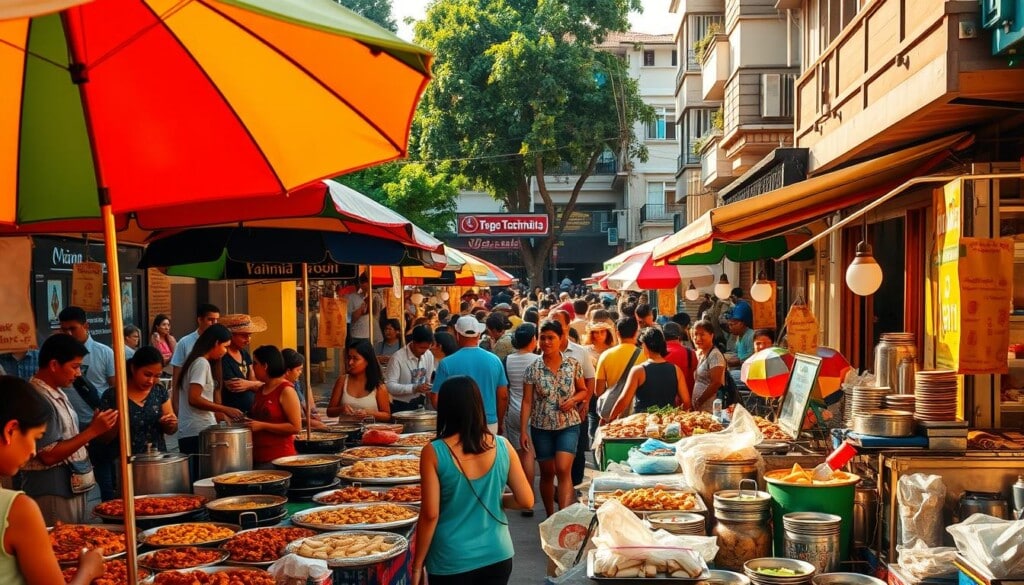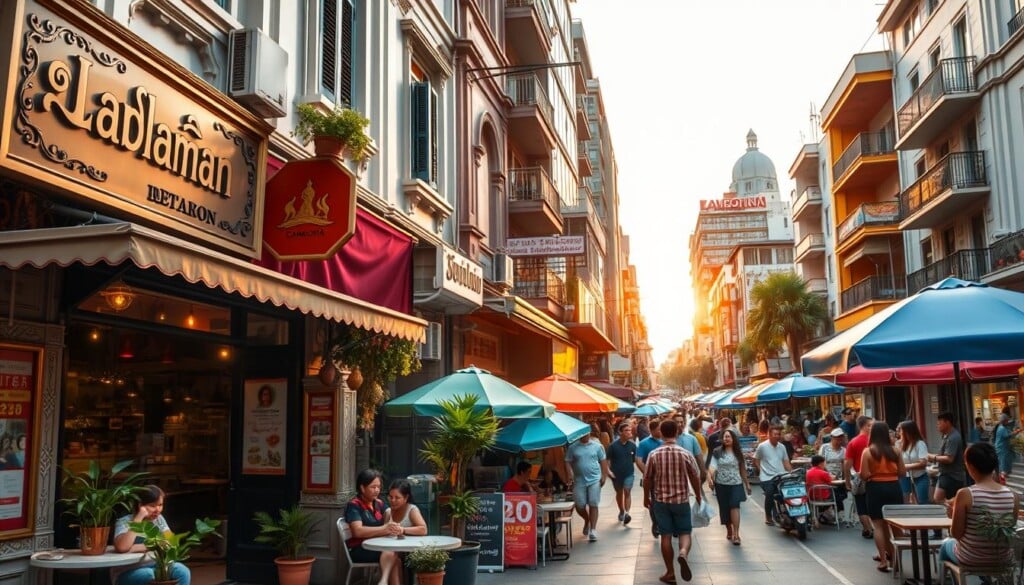Ever wondered why authentic Cambodian cuisine stands out in the world of food? As more people in the United States try Cambodian food, it’s key to understand its cultural depth and traditional cooking methods. This article will show you the top Cambodian restaurants in the U.S. It will give you a taste of Cambodia’s flavors and dishes passed down through generations.
If you love Khmer food or are new to Cambodian flavors, finding the best spots is important. These restaurants are key to keeping Cambodian cuisine alive in America. They offer a true taste of Cambodia and make dining more exciting.
Key Takeaways
- The growing popularity of Cambodian food restaurants in the U.S.
- Insights into the unique flavors and techniques of Cambodian cuisine.
- Identifying the best Cambodian restaurants across major cities.
- Understanding the significance of community in preserving culinary traditions.
- Tips for exploring hidden gems and local favorites in Cambodian dining.
Introduction to Cambodian Cuisine
Cambodian cuisine is a mix of history and flavor. It shows how different cultures have shaped its dishes. The food of Cambodia comes from Khmer, Chinese, and French traditions.
This mix of cultures has created a unique set of dishes. These dishes tell stories of the people’s strength and ability to adapt. The food of Cambodia has evolved over time, using local ingredients and cooking methods.
The Rich History of Cambodian Food
The history of Cambodian food shows the people’s resilience. Over the years, different cultures have added their spices and cooking ways. This has made a wide range of tasty dishes.
Events like colonial rule have also changed the way food is made. They brought in new ingredients and cooking styles. These changes have made traditional recipes even better.
Essential Ingredients in Cambodian Dishes
Key ingredients are at the heart of Cambodian cuisine. Rice is the main food, and fish sauce adds flavor. Palm sugar makes things sweet, and herbs like lemongrass add freshness.
Some dishes, like Amok and Num Banh Chok, show how these ingredients work together. They create meals that are both delicious and memorable.
Where to Find Cambodian Food Restaurants
Exploring the best Cambodian restaurants across the USA shows a rich mix of flavors and cultural experiences. Major cities are full of popular Cambodian dining spots. They also have hidden gems in local neighborhoods that add to the culinary scene.
Major Cities with Cambodian Culinary Offerings
Chicago, Los Angeles, and New York are known for their top Cambodian food spots. In Chicago, several establishments offer authentic Cambodian dishes that reflect the country’s rich culinary heritage. Los Angeles features a variety of excellent options, each putting a unique twist on traditional meals. Meanwhile, New York’s vibrant food scene includes Cambodian cuisine that adds depth and diversity to the local dining experience.
Hidden Gems in Local Neighborhoods
Small family-run kitchens in local neighborhoods offer a peek into Cambodian cuisine’s heart. These hidden treasures serve home-cooked meals that show true culinary traditions. Finding these spots not only lets you enjoy authentic flavors but also builds community connections. For the best Cambodian restaurants, check out LocalZ to find these local culinary gems.

What to Expect at a Cambodian Restaurant
Dining at a Cambodian restaurant is a unique experience. It shows the true taste of authentic Cambodian cuisine. Meals are shared, bringing people together as they enjoy traditional flavors.
The focus on communal dishes reflects Cambodian culture’s value on family and hospitality.
Traditional Dining Experience
At a Cambodian restaurant, you’ll find family-style servings. This lets guests try different dishes. It encourages diners to connect and enjoy the rich flavors of Cambodia.
Expect vibrant plates that delight both your taste and sight. In Cambodian culture, presentation is key.
Popular Cambodian Dishes to Try
Visiting Cambodian restaurants means trying their signature dishes. Amok, a steamed fish curry, is a must-try. It showcases the perfect mix of herbs and spices.
Lok Lak, a stir-fried beef dish with fresh veggies, highlights local ingredients. Num Banh Chok, a rice noodle dish, features a refreshing fish broth. Each dish offers a glimpse into Cambodian traditions, leaving a memorable taste.
How to Use LocalZ for Your Search
LocalZ is a great tool for finding Cambodian food restaurants and more. It has a user-friendly interface that makes searching easy. You can search for your favorite cuisine and location, helping you find top spots nearby.
Simple Search Features for Local Listings
Finding restaurants is simple with LocalZ. Just type in what you’re looking for, like Cambodian cuisine. You’ll get a list of places to eat quickly. It’s perfect for anyone wanting to try new foods.
Filtering Options for a Tailored Experience
LocalZ also has filters to make your search better. You can sort by distance, ratings, and special features. This way, you can find the perfect place to eat, based on what you like.

Customer Reviews and Recommendations
Customer reviews are key for finding the top Cambodian restaurants. People who have eaten there share their thoughts, helping others choose. They talk about the food, service, and vibe, which can differ a lot.
Importance of Reviews in Choosing a Restaurant
Looking for great Cambodian food? Reviews are a must. They offer real views on dining, beyond what ads say. This helps you pick a place that will meet your expectations.
How to Leave a Review on LocalZ
Sharing your thoughts on LocalZ helps everyone. You can tell others about your favorite spots. This way, you help others find great places and help restaurants know what people like. It makes the dining scene better for everyone.
Support Local Businesses with LocalZ
LocalZ helps local businesses, like Cambodian Food Restaurants, by showing off what they offer. This makes it easier for people to find and support them. LocalZ also gives back by sharing half of its yearly fees with local groups.
This helps build a strong community. It’s all about supporting each other and growing together.
The Impact of Local Business Listings
Being seen is key for local businesses. LocalZ makes sure Cambodian Food Restaurants get noticed. This brings in more customers and helps the local economy grow.
When you eat at a local place, you’re helping your community. You get great food and support your area’s economy at the same time.
Community Involvement through LocalZ
LocalZ brings people and businesses together. It shows off the hard work of local Cambodian Food Restaurants. This makes everyone proud to be part of the community.
By supporting local businesses, you’re helping your community thrive. You become a part of the local economy and help it grow.

Booking and Reservations
Making reservations at Cambodian food restaurants makes dining better. LocalZ makes it easy to book, so you can enjoy authentic dishes without worry. This way, you avoid disappointment when places are full, which often happens during busy times.
Making Reservations Directly through LocalZ
With LocalZ, booking your favorite Cambodian food spots is simple. The platform is easy to use, so finding a table is no hassle. Brands with a strong local presence give updates on availability, helping you plan your meals ahead.
Benefits of Planning Ahead
Booking ahead has many benefits. You save time and get to enjoy special dishes that need planning. It makes your dining experience better, letting you relax and enjoy your meal without stress.
Engaging with Local Organizations
LocalZ works hard to build strong ties with local groups. This helps boost community spirit and support for local shops. By teaming up with different community groups, LocalZ makes a space for everyone to work together. This is key in promoting Cambodian food spots.
Partnerships with Community Affiliates
These partnerships help LocalZ bring people together. They focus on goals that help both businesses and locals. Working with local groups makes the community stronger and brings out the best in local food.
How LocalZ Supports Local Causes
LocalZ does more than just promote local spots. They get involved in cultural events and projects. This makes the neighborhoods they serve more lively and proud.
It shows how important local groups are. It also makes the food scene better and encourages people to shop local.
Conclusion: Savor the Flavors of Cambodia
Exploring Cambodian cuisine is more than just tasting food. It’s about understanding the deep flavors and stories behind each dish. For those who love food and are curious, trying out Cambodian food restaurants is a special experience. It lets you dive into the heart of Cambodian culture.
Visiting local restaurants helps build a sense of community. It’s a chance to connect with others and learn about Cambodian food. By sharing these experiences, we keep the rich flavors of Cambodian cuisine alive.
For more food adventures, check out LocalZ. It’s a great place to find the best spots for delicious Cambodian dishes. Plus, it helps you connect with local businesses. So, start your culinary journey today and discover the true taste of Cambodia.

